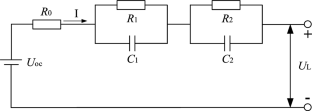Journal of Power Electronics ( IF 1.4 ) Pub Date : 2024-04-16 , DOI: 10.1007/s43236-024-00801-9 Zidi Yu , Jian Liu , Yuchen Lu , Chengzhi Feng , Letian Li , Qi Wu

|
The core equipment of lithium-ion battery energy storage stations is containers composed of thousands of batteries in series and parallel. Accurately estimating the state of charge (SOC) of batteries is of great significance for improving battery utilization and ensuring system operation safety. This article establishes a 2-RC battery model. First, the Extended Kalman Filter (EKF) algorithm is used to obtain preliminary SOC estimates. Then, the updated error values of the Kalman matrix, the state variables obtained from the EKF algorithm, and the battery data during system operation are used as the training and test dataset for the Long Short-Term Memory (LSTM) neural network algorithm. Finally, the algorithm was compared and analyzed with commonly used EKF estimation methods and LSTM algorithms. It was found that the root-mean-square error of the SOC of the EKF–LSTM algorithm under different operating conditions was less than 0.8%, and the average absolute error was less than 0.5%. The estimation accuracy is higher than either the EKF algorithm or LSTM algorithm alone.
中文翻译:

基于EKF-LSTM组合算法的增强型储能容器电池荷电状态估计
锂离子电池储能电站的核心设备是由数千个电池串并联组成的容器。准确估算电池的荷电状态(SOC)对于提高电池利用率、保证系统运行安全具有重要意义。本文建立了2-RC电池模型。首先,使用扩展卡尔曼滤波器(EKF)算法来获得初步的 SOC 估计。然后,将更新后的卡尔曼矩阵误差值、EKF算法得到的状态变量以及系统运行时的电池数据作为长短期记忆(LSTM)神经网络算法的训练和测试数据集。最后,将该算法与常用的EKF估计方法和LSTM算法进行了对比分析。结果发现,不同运行条件下EKF-LSTM算法的SOC均方根误差小于0.8%,平均绝对误差小于0.5%。估计精度比单独使用 EKF 算法或 LSTM 算法要高。



























 京公网安备 11010802027423号
京公网安备 11010802027423号